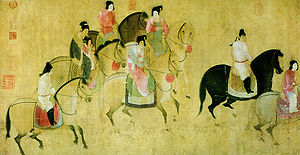


During the Tang dynasty, as a golden age in Chinese civilization, Chinese painting developed dramatically, both in subject matter and technique.The advancements in depth, technique, style, intricacy, complexity, and sophistication that characterized the paintings of the Tang era. This dramatic development was a consequence of the era’s embrace of openness and exploration into novel materials and techniques, contributing to new styles in landscape painting[1]. Literature on art, in addition to the increase in the range of colors, added to the development of painting, widening the artistic imagination[1]. However, this flourishing would not be possible without the interest and investment of the Tang court as it played a key role in bringing together painters from across the empire[2]. The court lent tremendous support to the painters, thanks to which, they could devote their time and energy to mastering skills, experimenting with forms and styles, and mastering the painting skills[2]. The court painters became more imaginative and creative, giving a new direction to landscape painting[2]. As a result, the Tang era had an everlasting influence influence on Central and East Asian art.
The court painters played a key role in defining female beauty uniquely, through their paintings, especially “the court lady paintings”[3]. Zhang Xuan and Zhou Fang were two key court painters dedicated to paying court ladies. Just by looking at their court paintings, one can imagine the ambience and the environment of the Tang court. Though the pioneer of Chinese court lady paintings was Mao Yanshou from the Han dynasty, the Tang dynasty gave the painting a different style by fusing Central Plain values with Central Asian values, reconceptualizing female beauty that went beyond canvases, to tomb murals, poems, and statuettes[3].
A considerable amount of literary and documentary information about Tang painting has survived, but very few works, especially of the highest quality. A walled-up cave in the Mogao Caves complex at Dunhuang was discovered by Sir Aurel Stein, which contained a vast haul, mostly of Buddhist writings, but also some banners and paintings, making much the largest group of paintings on silk to survive. These are now in the British Museum and elsewhere. They are not of court quality, but show a variety of styles, including those with influences from further west. As with sculpture, other survivals showing Tang style are in Japan, though the most important, at Nara, was very largely destroyed in a fire in 1949.[4]
The Tang dynasty saw the maturity of the landscape painting tradition known as shanshui (mountain-water) painting, which became the most prestigious type of Chinese painting, especially when practiced by amateur scholar-official or "literati" painters in ink-wash painting. In these landscapes, usually monochromatic and sparse, the purpose was not to reproduce exactly the appearance of nature but rather to grasp an emotion or atmosphere so as to catch the "rhythm" of nature. The long-lasting tradition of the Southern School began in this period.[5]
- ^ a b Cartwright, Mark. "The Art of the Tang Dynasty". World History Encyclopedia. Retrieved 2024-11-02.
- ^ a b c "Tang dynasty (618–907)". Smithsonian's National Museum of Asian Art. Retrieved 2024-11-02.
- ^ a b Zhang Fa (2016). The history and spirit of Chinese art. Volume 1: From prehistory to the Tang Dynasty. Honolulu Hong Kong Beijing Singapore: Silkroad Press. ISBN 978-1-62320-125-8.
- ^ Sullivan, 132-133
- ^ Sullivan, 136-139